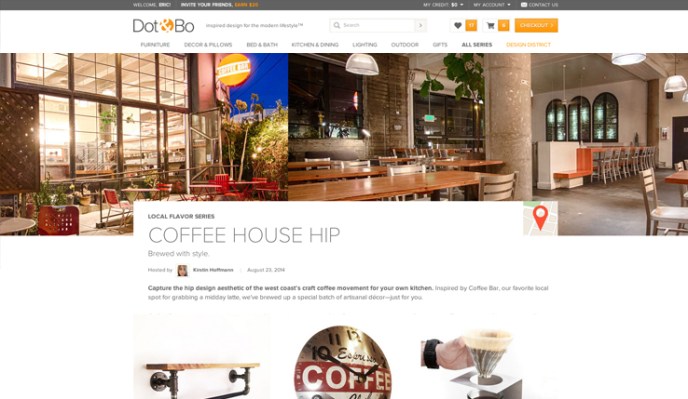You might know online retailer Dot & Bo mostly as a website for purchasing stylish home furnishings, but the company wants to be much more than that. In particular, it wants to be seen as a next-generation content and commerce destination — what you might think of as a kind of QVC for millennials.
Dot & Bo already has the commerce side locked down, but to ramp up its content, the company will be getting help from an entertainment veteran well-steeped in the production and programming of media. That’s because entertainment veteran Nancy Tellem is joining its board of directors.
Launched about a year-and-a-half ago, Dot & Bo specializes in the sale of home furnishings “designed for the modern lifestyle.” It appeals mostly to young people, in particular millennials, as they set out to decorate their first homes and attempt to make those homes look like the type of place a grown-up might live in.
It’s for customers who have grown out of IKEA, but haven’t quite graduated to Restoration Hardware. And, well, for those who want something a little more stylish than what they might find at Crate and Barrel.
From an inventory standpoint, the site has the type of furniture you probably won’t find at other retail chains or online. But what sets it apart is the way it presents its furniture into collections, and how it creates stories around items it has for sale.
The most obvious example of its content efforts is seen when you go to the home page and are presented with a carousel of collections, each of which is designed around a certain theme or decor. It also sends out regular newsletters to email subscribers with new and interesting groupings of products.
With its design inspiration series, Dot & Bo is seeking to go beyond just curating a bunch of items. Not unlike Pinterest, the goal is to inspire customers to mix and match items as they decorate their own homes.
As it ramps up content production, the company will lean on some of Tellem’s experience in programming for consumers. Most recently president of Microsoft’s now-defunct Entertainment and Digital Media division, Tellem has spent decades in traditional media trying to figure out exactly how to engage and connect with exactly the audience that Dot & Bo hopes to court as customers.
“What’s happening now in my business is there’s a lot of disruption going on and a focus on the millennial audience,” Tellem said in a phone interview. But, she added, “traditional TV is having a difficult time reaching them.”
Dot & Bo, by contrast, has largely succeeded in connecting with those consumers through a mix of content and commerce. To reach them, Tellem says, you have to be authentic, personal, and highly engaging, something which the company aspires to.
Dot & Bo co-founder Anthony Soohoo has known Tellem for years, since they worked together at CBS. Together they bring a mix of digital and traditional media experience that Dot & Bo is hoping to leverage as it seeks to flip the model of content creation and monetization.
At CBS Soohoo worked on the digital side of the house, handling online distribution of the company’s video properties at CBS Interactive. Tellem, meanwhile, served as president of the CBS Network Television Group, where she oversaw development, production, and programming of shows on the company’s networks.
One of the properties that reported to Tellem was The CW, the joint venture between CBS and Warner Bros. that targeted teens and young adults. With shows like Gossip Girl, the network had some success not just in attracting an audience of those viewers, but also connecting them with songs that were part of the show’s soundtrack or part of its closing credits.
As it relates to Dot & Bo’s content plans, the goal is to go even further in making content that is monetized by commerce attached to it. Because it has a connection with its visitors, Soohoo believes Dot & Bo can close the loop on a sales process online that was never possible in the one-way analog industries like TV, newspaper, or radio.
In that sense it also differs from other e-commerce companies in that it’s trying to drive more engagement at the top of the sales funnel, rather than trying to optimize for transactions. Tellem believes that’s a winning strategy. After all, she posits, creating compelling content leads to more engagement, and over time that leads to more sales.
Creating content for an e-commerce site might be a roundabout way of getting there, but it appears to be working.
